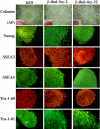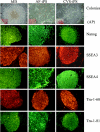Induced pluripotent stem cells offer new approach to therapy in thalassemia and sickle cell anemia and option in prenatal diagnosis in genetic diseases
- PMID: 19482945
- PMCID: PMC2701047
- DOI: 10.1073/pnas.0904689106
Induced pluripotent stem cells offer new approach to therapy in thalassemia and sickle cell anemia and option in prenatal diagnosis in genetic diseases
Abstract
The innovation of reprogramming somatic cells to induced pluripotent stem cells provides a possible new approach to treat beta-thalassemia and other genetic diseases such as sickle cell anemia. Induced pluripotent stem (iPS) cells can be made from these patients' somatic cells and the mutation in the beta-globin gene corrected by gene targeting, and the cells differentiated into hematopoietic cells to be returned to the patient. In this study, we reprogrammed the skin fibroblasts of a patient with homozygous beta(0) thalassemia into iPS cells, and showed that the iPS cells could be differentiated into hematopoietic cells that synthesized hemoglobin. Prenatal diagnosis and selective abortion have been effective in decreasing the number of beta-thalassemia births in some countries that have instituted carrier screening and genetic counseling. To make use of the cells from the amniotic fluid or chorionic villus sampling that are used for prenatal diagnosis, we also showed that these cells could be reprogrammed into iPS cells. This raises the possibility of providing a new option following prenatal diagnosis of a fetus affected by a severe illness. Currently, the parents would choose either to terminate the pregnancy or continue it and take care of the sick child after birth. The cells for prenatal diagnosis can be converted into iPS cells for treatment in the perinatal periods. Early treatment has the advantage of requiring much fewer cells than adult treatment, and can also prevent organ damage in those diseases in which damage can begin in utero or at an early age.
Conflict of interest statement
The authors declare no conflict of interest.
Figures






Similar articles
-
Gene and Cell Therapy for β-Thalassemia and Sickle Cell Disease with Induced Pluripotent Stem Cells (iPSCs): The Next Frontier.Adv Exp Med Biol. 2017;1013:219-240. doi: 10.1007/978-1-4939-7299-9_9. Adv Exp Med Biol. 2017. PMID: 29127683
-
Generation of human β-thalassemia induced pluripotent stem cells from amniotic fluid cells using a single excisable lentiviral stem cell cassette.J Reprod Dev. 2012;58(4):404-9. doi: 10.1262/jrd.2011-046. Epub 2012 Apr 13. J Reprod Dev. 2012. PMID: 22498813
-
Rapid Detection of Fetal Mendelian Disorders: Thalassemia and Sickle Cell Syndromes.Methods Mol Biol. 2019;1885:207-219. doi: 10.1007/978-1-4939-8889-1_14. Methods Mol Biol. 2019. PMID: 30506200
-
Gene Addition Strategies for β-Thalassemia and Sickle Cell Anemia.Adv Exp Med Biol. 2017;1013:155-176. doi: 10.1007/978-1-4939-7299-9_6. Adv Exp Med Biol. 2017. PMID: 29127680 Free PMC article. Review.
-
Recent advances in globin gene transfer for the treatment of beta-thalassemia and sickle cell anemia.Curr Opin Hematol. 2006 May;13(3):142-8. doi: 10.1097/01.moh.0000219658.57915.d4. Curr Opin Hematol. 2006. PMID: 16567956 Review.
Cited by
-
Generation of induced pluripotent stem cells from human mesenchymal stem cells of parotid gland origin.Am J Transl Res. 2016 Feb 15;8(2):419-32. eCollection 2016. Am J Transl Res. 2016. PMID: 27158336 Free PMC article.
-
Metabolic correction of congenital erythropoietic porphyria with iPSCs free of reprogramming factors.Am J Hum Genet. 2012 Jul 13;91(1):109-21. doi: 10.1016/j.ajhg.2012.05.026. Am J Hum Genet. 2012. PMID: 22795135 Free PMC article.
-
Osteogenic Differentiation of Human Amniotic Fluid Mesenchymal Stem Cells Is Determined by Epigenetic Changes.Stem Cells Int. 2016;2016:6465307. doi: 10.1155/2016/6465307. Epub 2016 Oct 12. Stem Cells Int. 2016. PMID: 27818691 Free PMC article.
-
Production of embryonic and fetal-like red blood cells from human induced pluripotent stem cells.PLoS One. 2011;6(10):e25761. doi: 10.1371/journal.pone.0025761. Epub 2011 Oct 13. PLoS One. 2011. PMID: 22022444 Free PMC article.
-
Induced pluripotent stem cells as a next-generation biomedical interface.Lab Invest. 2011 Jul;91(7):972-7. doi: 10.1038/labinvest.2011.85. Epub 2011 May 9. Lab Invest. 2011. PMID: 21555998 Free PMC article.
References
-
- Weatherall D, Clegg J. The Thalassaemia Syndromes. 2nd Ed. New York: Wiley-Blackwell; 2001.
-
- Giardini C, Lucarelli G. Bone marrow transplantation for beta-thalassemia. Hematol Oncol Clin North Am. 1999;13:1059–1064. - PubMed
-
- Locatelli F, et al. Related umbilical cord blood transplantation in patients with thalassemia and sickle cell disease. Blood. 2003;101:2137–2143. - PubMed
-
- Rivella S, May C, Chadburn A, Riviere I, Sadelain M. A novel murine model of Cooley anemia and its rescue by lentiviral-mediated human beta-globin gene transfer. Blood. 2003;101:2932–2939. - PubMed
-
- Pawliuk R, et al. Correction of sickle cell disease in transgenic mouse models by gene therapy. Science. 2001;294(5550):2368–2371. - PubMed
Publication types
MeSH terms
LinkOut - more resources
Full Text Sources
Other Literature Sources
Medical

